A s i a n W o r l d M u s i c
DANOBI
| |
|
Since 1992, the 'DANOBI' band has been featured on NHK TV and local television and radio broadcasts throughout Japan. 'DANOBI' is an instrumental, jazz inspired, 'Asian World Music Ensemble' featuring music from China, Japan and the US. The band includes percussion instruments from around the world and features the ancient Japanese pottery drum, the Jyoumon Taiko. These drums are featured on the group's first album, Mark DeRose Group 'DANOBI'.
'DANOBI' is a delicate blend of Eastern and Western music cultures featuring the exotic sounds of the erhu from China, the shakuhachi from Japan, the accordion from Europe and drums from around the world. This 'Asian World Music' ensemble has a unique and creative international sound. Elements of jazz, Japanese and Chinese folk music can be heard in the rhythms and melodies of the arrangements and original compositions.
The 'DANOBI' band first appeared with its 'Asian World Music' concept in 1992 at the Kyoto City 1200th Year Celebration, held at the prestigious Gaburenjo in Kyoto City, Gion. NHK televised and national media coverage followed marking the start of this original 'Asian World Music' ensemble.
|
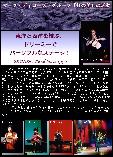 |
| DANOBI J-Text |
|
|
 |
| DANOBI J-Profile |
|
|
'DANOBI' is an original Japanese word I created to describe the heart and soul of the group's music. The Japanese script/character or kanji 'DA' (pronounced like the 'da' in 'da Vinci') means 'to strike' or 'to hit'. 'DAGAKKI' is the Japanese word for percussion instrument or instruments played by striking. The 'NO' in DANOBI is translated as the pronoun 'of' and 'BI' (pronounced bee - bumblebee) is translated as 'beauty'. And so we have 'Beauty of the Beat' or 'Beauty of Percussion' or 'Percussive Beauty'. All of the instruments in this ensemble were chosen for their percussive beauty as well as their other wonderful qualities.
'DANOBI' is an important source of 'Asian World Music' and a substantial force in changing the way people in Japan create, perform and listen to music!
|
~~~~~~~~~~~~~~~~~~~~~~~~~~~~~~~~~~~~~~~~~~~~~~~~~~~~~~~~~~~~~~~~
|
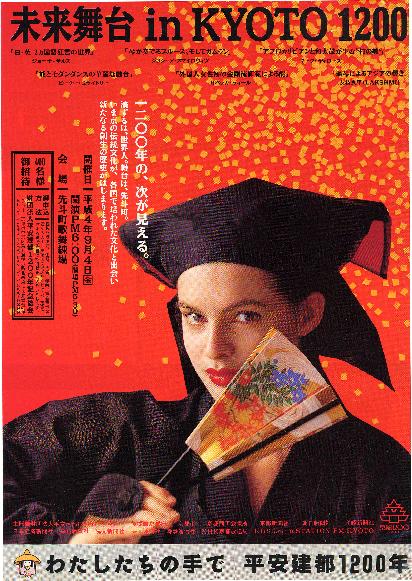 |
| Kyoto's 1200th Year Celebration |
|
|
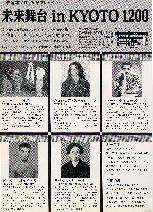 |
| J-Text |
|
|
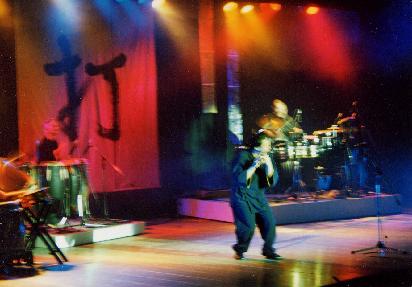 |
| '92 DANOBI Premiere Stage |
|
|
1992-1994
* Kyoto 'Heian Kento 1200 Nen Celebration' (Kyoto City's 1200 Year Celebration Festival)
* 'DANOBI' concerts, live house and jazz clubs. Regular performances at the Roppongi 'Valentine' club.
1995
* Sumidaku City Hall New Year Concert
* Seshion Suginami 'DANOBI' Concert
1996
* Minatoku City Hall New Year Concert
1997
* Daikanyama Hills, Mark DeRose Group DANOBI Concert
* CD Recording 'Mark DeRose Group DANOBI'
* Live/Concert CD Release Tour
* 'Kokusai Kyoroku Festival 1997' Hibiya Yagai Ongakudou (International Volunteer Festival, Hibiya Open Air Concert Arena)
1998
* Hakone Chokoku no Mori Art Museum, 'Evening Art Fantasie Concert'
* Asagaya Jazz Streets Festival Evening Concert
1999
* New Port Jazz Festival in Madarao
* Mark DeRose Group DANOBI Concert, Cowbell Hall, Tottori
* Asagaya Jazz Streets Festival Evening Concert
2000
* Mark DeRose Group DANOBI Concert, Biwako Hall, Shiga
* Hakone Chokoku no Mori Art Museum, 'Evening Art Fantasie Concert'
* Danobi Concert in Tohoku
2001
* Danobi Concert Tottori Hall
* Danobi Concert Mirai Chushin Hall
* Asagaya Jazz Streets Festival Evening Concert
|
Mark DeRose and Rising Sun Records is proud to present the 'DANOBI' band's featured artists. These world class musicians are amongst the finest in Asia and undoubtedly represent the true 'heart & soul' of their native lands.
|
.jpg) |
| Shakuhachi (Japan) |
|
|
The shakuhachi is the popular end-blown bamboo flute from Japan. It is traditionally made from the root end of the tree and is approximately 22" or 55 cm. in length. This instrument has 4 fingerholes on the front and a thumbhole on the upper backside. The range may sound 2 1/2 octaves or more. The shakuhachi's fundamental scale or key is pentatonic: d, f, g, a, c, d and may be expanded to encompass scales or keys which contain semitones. These tones are created by half-covering the holes with the fingers. The blowing techniques control timbre, pitch and the sliding up to a fundamental note.
The shakuhachi attained its original form in the 17th century. Originally an instrument of Zen Buddhism, it was carried by the wandering priests and often used for protection. The instrument very often took the place of the sword which the priests were forbidden to carry.
The 'DANOBI' band features this instrument in the classical repertory - 'honkyoku' and 'gaikyoku' - pieces played in combination usually with koto and recently with other instruments from both the East and West.
Please see our first album for original, honkyoku, Chinese and Japanese folk music arranged for the shakuhachi.
|
The erhu or Chinese fiddle is perhaps the most popular variety among the bowed instruments known collectively as huqin or hu-ch'ing. The body of the instrument is small, approximately 5" or 13cm. in length and 3" or 8 cm. wide and can be hexagonal or octagonal in shape. Usually made of wood (other varieties include bamboo) and covered with lizard-skin on the front and open on the back. The neck of the instrument is usually made of bamboo and is approximately 24" or 60 cm. long. The erhu (er, 'two') has two strings and is strung much like a violin with 2 seperate tuning pegs at the top and a bridge across the skin of the body. The bow of the instrument passes between the strings at the body and must be attached before each performance by detaching the end portion of the bow and reattching after the bow hairs have been placed between the strings and the instrument is usually played sitting down with the body resting on the thigh or lap of the player.
The sound is similar to the violin, expressive and passionate. Players perform with a somewhat exagerated vibrato technique characteristic of the instruments unique, exotic sound.
The selection 'Saima' from our first CD is an interesting example of the erhu or 'niko' as it is called in Japan. This selection has been arranged for erhu and Jyoumon Taiko.
|
 |
| Erhu (China) |
|
|
 |
| Shamisen (Japan) |
|
|
The shamisen is the Japanese long lute derived from the Chinese sanxian. The small square like body is covered with catskin (used by the geisha in traditional format) or dogskin, a tougher skin which supports the hard and percussive style represetative of the Japanese folk music from the Northern region of the main island called Tohoku. The Tohoku shamisen is refered to as the 'Tsugaru Jamisen' .
The neck or fret board has no frets and the strings are made from specially wound silk cords and struck with a large wooden or turtle shell plectrum. There are a total of 3 strings which are tuned in fourths, fifths and alternate variations fitting vocalists and selected keys of the music to be performed. It is for this reason the shamisen player constantly tunes the instrument in preparation for the next song in a performance.
The strong, fast, percussive 'hard style' of the Tsugaru Jamisen is featured on our fist CD. The selection 'Tsugaru Jyoungara Bushi' has been arranged with wadaiko, Latin percussion, a full rhythm section including electric guitar. A very different approach to performing this classic folk song of Northern Japan.
|
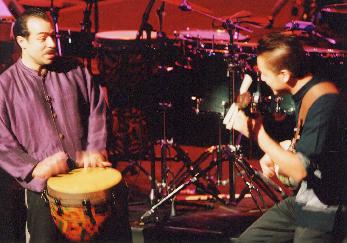 |
| Djembe & Shamisen "Joungara Bushi" |
|
|
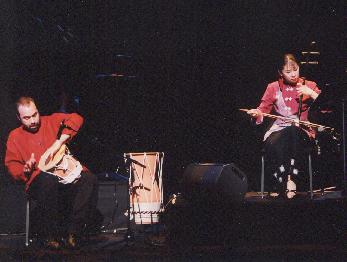 |
| Jyoumon Taiko & Erhu "Saima" |
|
|
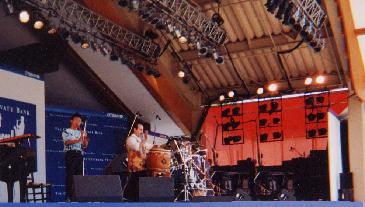 |
| 'DANOBI' at '99 Newport Jazz Festival |
|
|
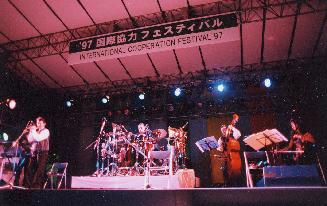 |
| Tokyo International Festival |
|
|
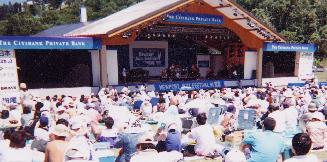 |
| Newport Jazz Festival Stage |
|
|
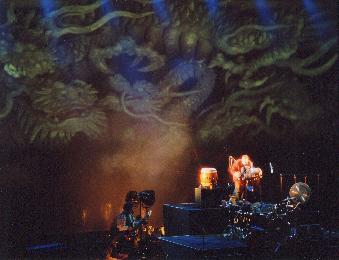 |
| 'DANOBI' Concert Biwako Hall |
|
|
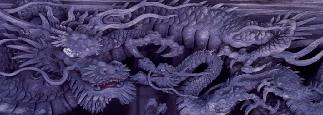 |
| Photo by K. Sasaki |
|
| This Dragon image was hand carved in wood centuries ago on the main gate of the Rinshouji Temple in Nagano Prefecture where the 'DANOBI' band created its first live CD recording in 1996.
|
This DANOBI dragon picture/image and all rights contained therein, are restricted. Written consent for usage must be
obtained through Rising Sun Records and Mark DeRose. Unlawful duplication and/or reproduction will be prosecuted.
|
|